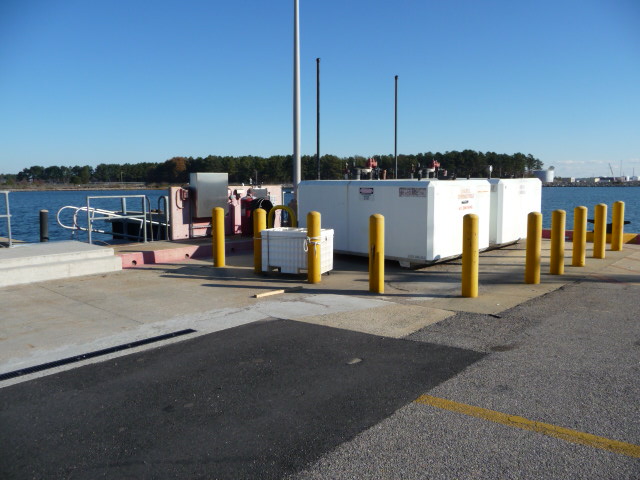
General Description
Fueling of vessels, trucks, and other equipment (i.e., onshore steam generators) along with the storage of fuel in aboveground or underground storage tanks. Fuel includes: diesel, kerosene, gasoline, and biofuels.
Summary of Federal Requirements
The storage of fuel from aboveground or underground storage tanks is managed the same regardless of whether they are at a port/harbor or elsewhere. Click here to visit the Storage Tanks section of the Facility Regulatory Tour.
The fueling of motor vehicles at a port/harbor is managed the same as vehicle fueling elsewhere. Click here to visit the Fuel Dispensing portion of the Vehicle Maintenance section of the Facility Regulatory Tour.
When fueling vessels, the transfer of oil (including fuel oil) from shore to vessel is regulated by the Coast Guard under 33 CFR 156. These Coast Guard requirements only apply to the transfer of oil on the navigable waters or contiguous zone of the United States to, from, or within each vessel with a capacity of 250 bbl [10,500 gal] or more. Under these requirements oil must not be transferred unless a declaration of inspection form has been filled out and signed and a copy of the declaration is kept on board the vessel or at the facility for at least 1 mo from the date of signature.
Transfer operations must not happen unless:
- the moorings are strong enough to hold during expected conditions and long enough to allow for adjustments;
- transfer hoses and loading arms are long enough to allow the vessel to move without straining hoses;
- each hose is supported to prevent kinks or other damage to the hose and strain on its coupling;
- each part of the transfer system is aligned to allow the flow of oil;
- parts of the transfer system not needed for the transfer are shutoff or securely blanked;
- the end of each hose and loading arm that is not connected for the transfer is blanked off;
- the transfer system is attached to a fixed connection on the vessel and the facility except that when a vessel is receiving fuel, an automatic back pressure shut off nozzle may be used;
- each overboard discharge or sea suction valve that is connected to the vessel's transfer or cargo tank system is sealed or lashed in the closed positions, except when in use;
- transfer hoses have no unrepaired loose covers, kinks, bulges, soft spots, or any other defect that would permit the discharge of material;
- drains and scuppers are closed by mechanical means; and
- connections in the transfer system are leak free.
Additionally, discharge containment equipment must be readily accessible and if there is a discharge in the transfer operation work area or into the water or on the adjacent shoreline in the transfer area, transfer operations of oil is stopped. The transfer of oil may not re-start until the prior discharge is contained and cleaned up.
Summary of State Requirements
States may have more stringent requirements for the prevention of air emissions during the transfer of fuel. States may also have more stringent requirements for spill notifications and cleanup.
Laws and Statutes
Clean Air Act
Clean Water Act
Resource Conservation and Recovery Act, Subtitle C
Resource Conservation and Recovery Act, Subtitle I
Underground Storage Tank Compliance Act (Title XV, Subtitle B of the Energy Policy Act of 2005)



